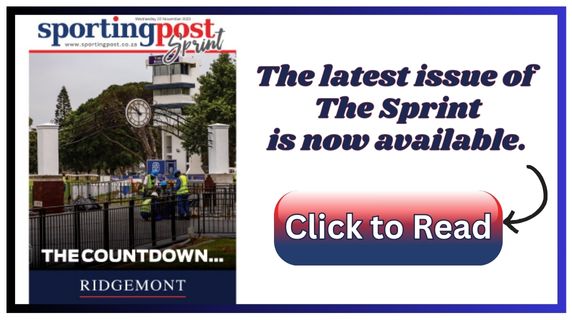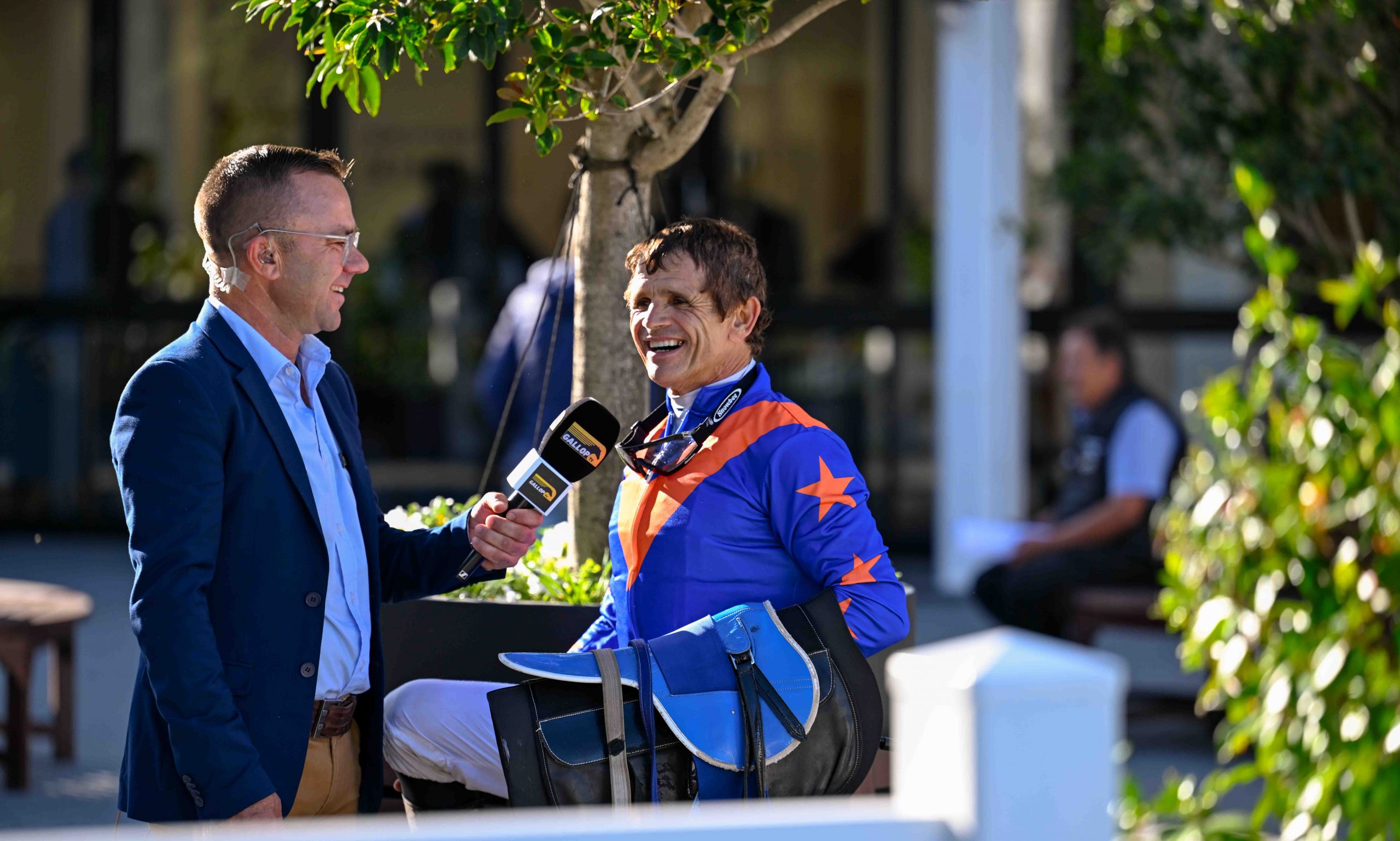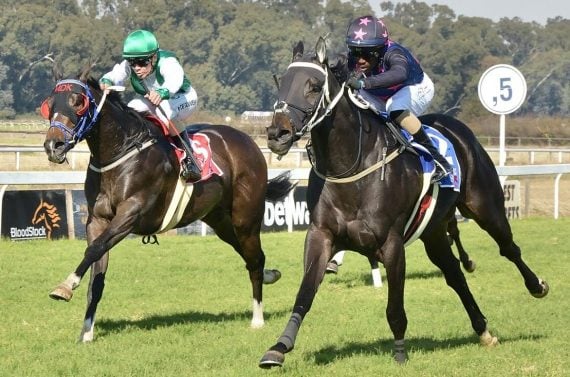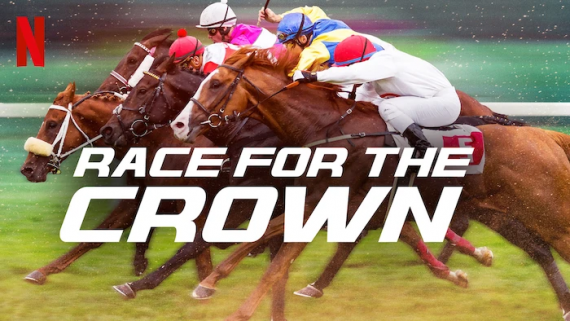In 1874, the members of the South African Turf Club chose a site on the farm Kenilworth for the construction of a new racecourse – which means that next year in 2024, the foundation of the oldest racetrack in South Africa will celebrate 150 years.
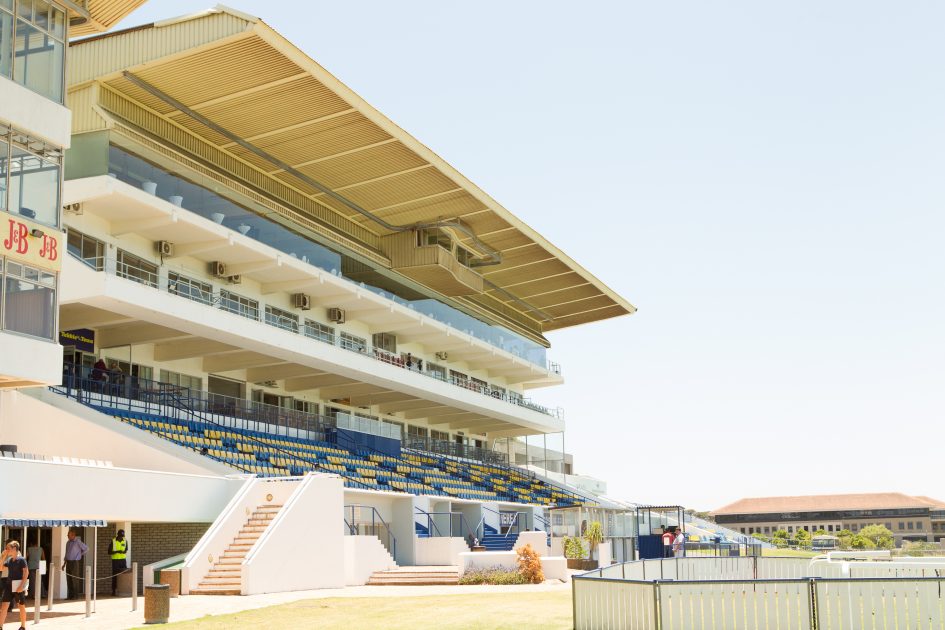
Kenilworth Grandstand, 2010 (Pic courtesy of Robin Bruss)
Robin Bruss writes that choosing a site on flat ground some 16 km from the existing Green Point track in Cape Town was a brave and inspired move because it was a fairly long journey for the public from the city centre.
However, it was encouraged by the establishment of local municipalities and the development of the railway line from the city to Muizenberg which had begun in 1859.
The South African Turf Club comprised around 40 members and already had a substantial history since it began in 1802 as the organizers of racing on Cape Town’s Green Point Common.

Met Panoramic (Pic – Robin Bruss)
Remembering our history, the first Dutch colonists arrived in 1652 and found no indigenous horses at all and needing working horses for transport and pack animals, so they began importing horses on their shipping trade routes.
Initially horses came from Java (now Indonesia) and others of Arabian strain from Persia (now Iraq), then in the 1700s the main supplier to South Africa was South America, whose origins were Spanish Andalusians. The first English horses only arrived in 1792.
South Africa was a hardy country to breed re-mounts for the military and during the 1800s, horse breeding flourished.
According to the British Bloodstock Breeders Review, thousands of Cape breds, were exported by boat in service of the British Empire.
In the Crimean Wars (1853 to 1856) the allies British, Turkey and France on one side and Russia on the other battled for control of Crimea, later to become part of Ukraine, until wrestled back by Russia in more recent times.
The bulk of the horses used by the allies were known as Cape horses – and at least 450 were killed in the ill-fated Charge of the Light Brigade, made famous by Tennyson’s epic poem : “Theirs not to reason why/ Theirs but to do and die/, Into the valley of Death Rode the Six Hundred.”
Cape horses reached Basutoland (now Lesotho) and developed into the breed known as Basuto ponies, famed for their toughness and endurance and thousands were sent from Durban to India, plus the British discovered they were better than they own breeds and purchased 30,000 for use in the Boer Wars.
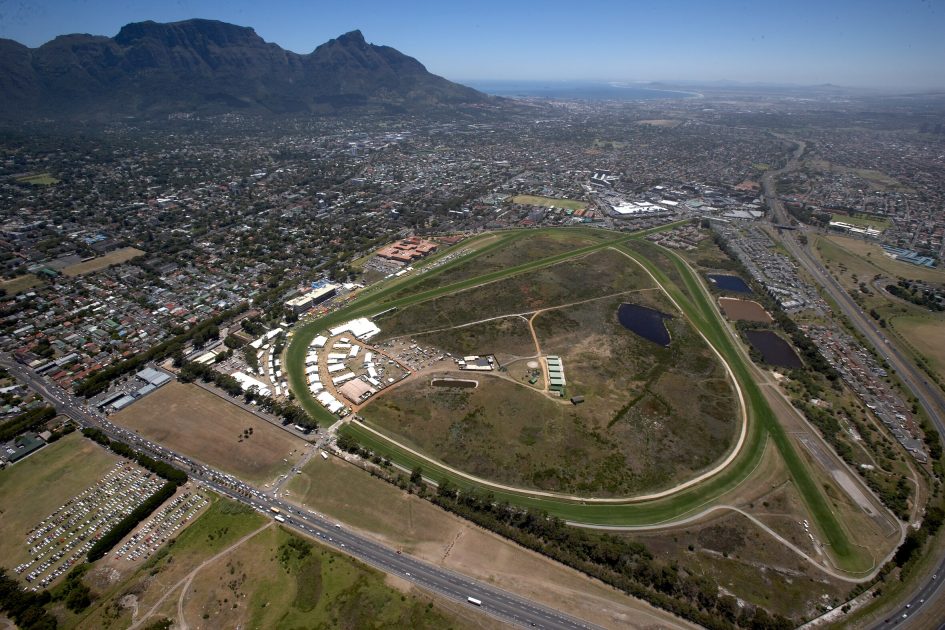
Aerial view of Met day – some years ago (Pic courtesy of Robin Bruss)
It was therefore not surprising that the Governors of the Cape would enact laws to encourage the breeding and farming of horses and as the racing of thoroughbreds became the main social sport, the Government also provided £3,000 funding for the building of Kenilworth racecourse.
The British had occupied the Cape Colony in 1795 and within two years, the first ‘African Turf Club’ was raised by the British garrison with 29 members using military horses to race against each other.
The race meetings were twice a year on Green Point Common and filled with social events culminating in a grand ball at the Turf Club House in Adderley Street.
The Green Point common was stony and unfenced and also used for grazing cattle and a flag would be raised before the start to indicate the course for the race was clear to run.
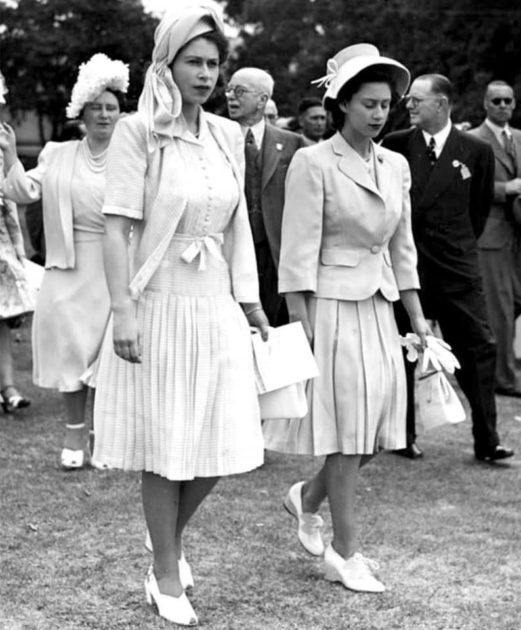
Princess Elizabeth 11 and Princess Margaret visit Kenilworth in 1947
In 1814, it was decided something more formal was required and the Governor of the Cape Colony, Lord Charles Somerset, passed laws to protect the Green Point track and replaced the soldier’s Turf Club with a new one, The South African Turf Club with 40 members of higher social standing.
Somerset imported thoroughbreds from England, started his own stud and became very successful on the turf as the leading owner.
His name is commemorated in the Somerset Plate still run today.
In 1828, the first South African Derby was run in Cape Town, later to move to Johannesburg, and in 1861, Queen Victoria donated a silver plate for the inaugural Queens Plate, which in January will be run at for the 153rd time, now the L’Ormarins Kings Plate.
Construction of the oval shaped Kenilworth racecourse was completed by the end of 1881, and the first grandstand built. The first racemeeting was held in April 1882.
The President of the South African Turf Club by then was Sir Hercules Robinson, who was also Governor of the Cape Colony, and the British High Commissioner – but also he was an ardent and active participant in racing as owner of the leading stable.
It’s probably no surprise to record that the following year, 1883, saw the first running of The Metropolitan at Kenilworth as Cape Town’s premier race and it was won by a four year old named Sir Hercules!
As towns sprang up throughout South Africa, horseracing spread to many country districts and new social Turf Clubs emerged – in Paarl, Uitenhage, Stellenbosch, Graaff-Reinet Grahamstown, Somerset West, Swellendam, George, Cradock, Port Elizabeth, Kimberly, Bloemfontein, and Natal, where the first meeting was held in 1844 in Pietermaritzburg.
With the discovery of gold on the Witwatersrand, racing began in Johannesburg in the 1880s.
The Johannesburg Turf Club was formed in 1887 and the flagship Turffontein Racecourse established in 1899. This means that in 2024, Turffontein will celebrate its 125th anniversary.

Kenilworth in the magic days of the 1930’s – look at the crowd! (Pic courtesy of Robin Bruss)
By 1900, there were more than 100 Racetracks and Turf Clubs spread all over South Africa. By early 2000, corporatization and amalgamation were the buzzwords and the Turf Clubs ceased to exist.
The Jockey Club of South Africa had been founded in 1882. The Racing Calendar recorded the results and the first General Stud Book was published in 1894.
Kenilworth Racecourse and the South African Turf Club remained important because of its concentration of horse breeding in the Cape, but gold endowed Johannesburg hosted the richest racing for the next 125 years.
It’s ironic that in 1996, some 109 years after its founding, the Johannesburg Turf Club was collapsed in favour of corporatization in the form of public company Phumelela which was listed on the Johannesburg Stock Exchange in 2001.
This caused the closure of all the Turf Clubs country wide on the grounds of being anachronistic and not needed in the modern era.
The experiment of 20 years of corporatization of the sport failed as it focused on extracting shareholder dividends from gambling at the expense of the ethos of the Sport, and the collapse of the Clubs diminished the sport’s support base.
The newly formed Cape Turf Club and the restoration of Kenilworth racecourse as a multi purposed venue now sits at the heart of racing’s re-emergence, thank goodness.
Whilst History is defined as the study of past events over time, it embraces so much more colour when we remember the great personalities that influenced and shaped events, and the great horses that graced the hallowed turf that is Kenilworth racecourse.
In the past 140 years, how many starters have raced at Kenilworth? Over a million ? And how many participants and fans have come through the turnstiles, to enjoy a day out and marvel at the spectacle and have a flutter on the outcomes!
It’s stories might fill an overdue book with exciting tales of glorious victories, crushing losses, absolute triumph as well as despair, glamour and fame, heartbreak and redemption in this amazing sport we all love.
I choose to remember just a few:
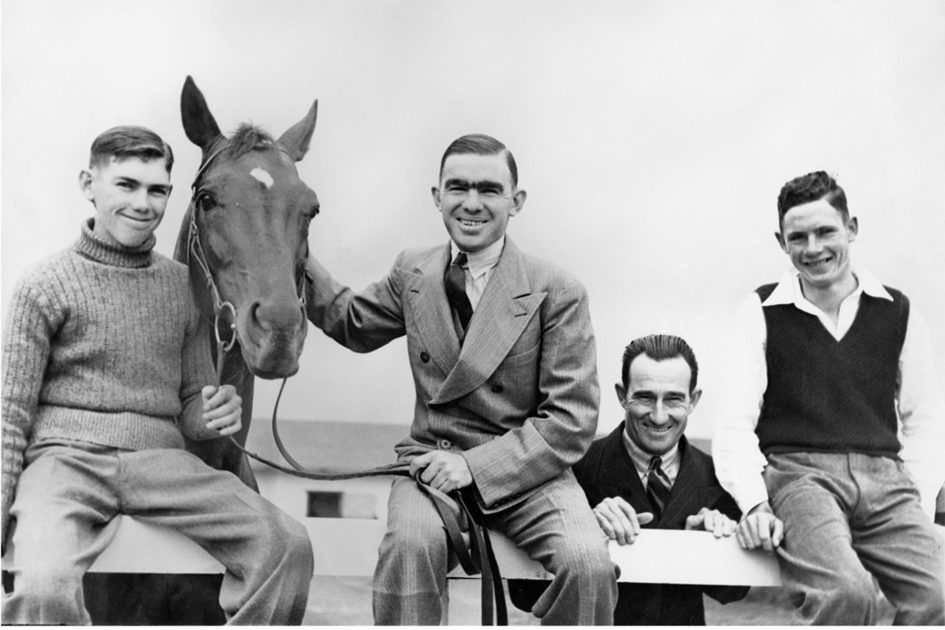
Stanley Amos, Cookie Amos, Champion Trainer Syd Garret and Freddie Hayman pictured with Moonlit, who Stanley rode to victory at Kenilworth in the Met of 1938 carrying 145 lbs
Syd Garret, uncle of future Champion Trainer Syd Laird, was known as the Wizard of ‘Roamer Lodge’ became a legendary trainer whose feats are a long way from being equaled.
He won the Met at Kenilworth 11 times as well as training four July winners, his apprentices were the Amos Brothers, Cookie, later to become a champion trainer himself, and Stanley, another legend who started race riding at 14 and continued until 65 years old, and finally retired after 72 years in racing.
In 1938, Cookie rode Syd’s greatest horse Moonlit to win the 1938 Met in a canter carrying 145 lbs (66kg), his second win in the race. In between he was 2nd in the Met by a head to his stablemate, French bred Asbestos II (FR), ridden by Stanley carrying 32 bs less!
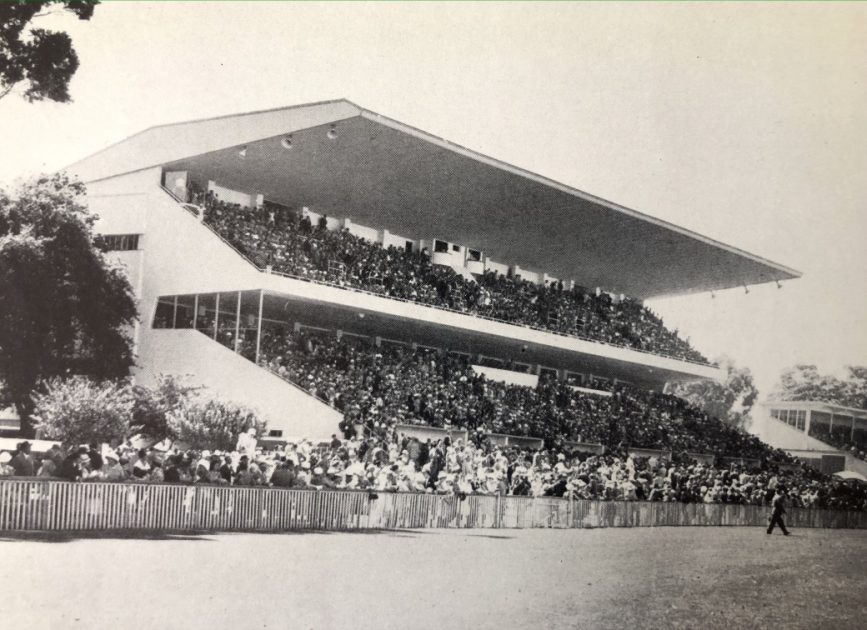
Kenilworth Grandstand in1961 (Pic courtesy of Robin Bruss)
Asbestos II later became 5 times Champion Sire in South Africa. Cookie proclaimed in an interview with Charles Faull in 1987 that Moonlit was a better horse than Sea Cottage or Hawaii or any champions of the previous 50 years.
Eight of his 12 wins were at Kenilworth and apart from two Mets, he also won Top division up the Kenilworth 6 furlong straight conceding 46 lb (21 kg) to the best sprinters of the day. Travelling out of town, he won the Durban Merchants over 6 furlongs and the South African Derby at Turffontein over 12 furlongs.
“I rode many of the great horses for more than 50 years” said Stanley, “none of them would have lived with Moonlit, the greatest of them all”.
I recall in 1983 standing in the parade ring with owner Sydney Press and Stanley Amos, then 64 years old and Sydney asked famed trainer Terrance Millard: “What qualifies this old man to ride my horse Gallantry?”. “His experience !” shot back Millard.
And then the horse came out and won !
Apart from Moonlit in the 1930s, the Syd Laird trained Sea Cottage, who won the 1966 Queens Plate and Cape of Good Hope Derby at Kenilworth amongst his 20 wins, is regarded by most as the best horse to have raced on the Kenilworth Turf.
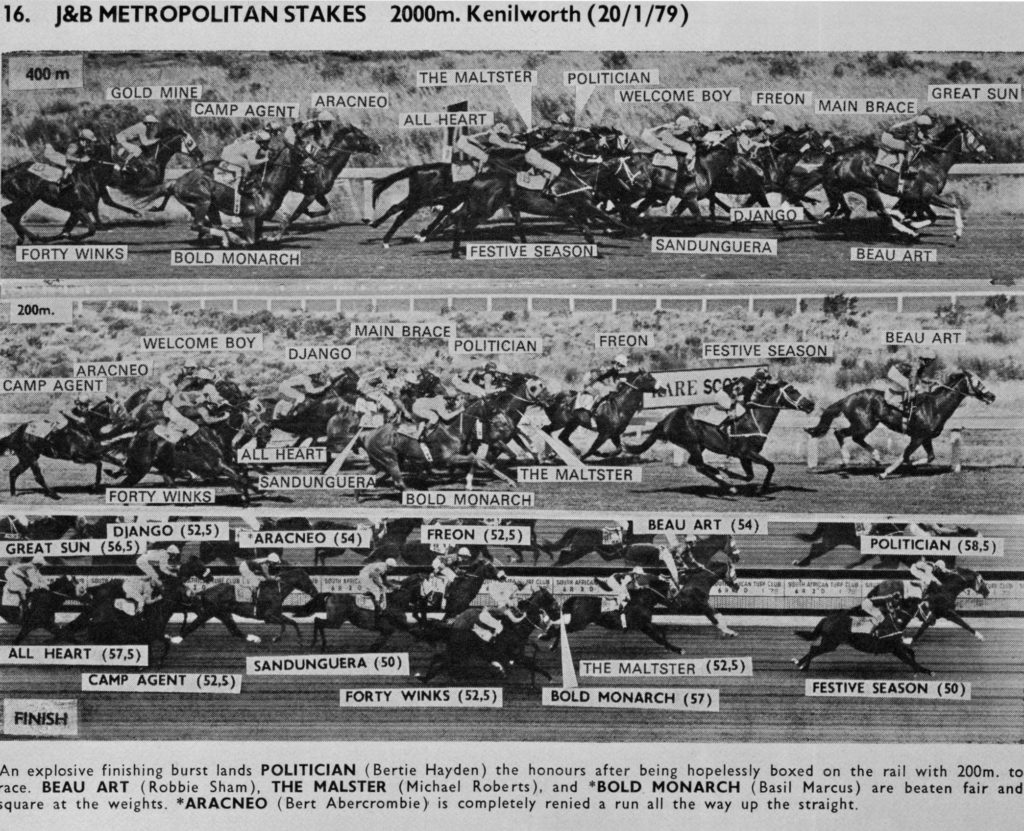
1979 J&B Met finish
I never saw him run, but I was on hand when Politician, who won 11 Grade 1 races, won the Met for the second time back in 1979.
The grandstand was so packed, I took an old wooden chair and put it at the back just under the rafters so I could stand on top and watch over the heads of the thousands who came to see Politician make history.
Trainer Syd Laird was so excited he jumped astride the horse in the winner’s box!
Foveros (1982), Wolf Power (1984), the great mares Olympic Duel (1991) and Empress Club (ARG) (1993), London News (1997) and the great Pocket Power’s unique treble for the Mike Bass stable (2007, 2008 and 2009) all remain deeply etched in the memory.
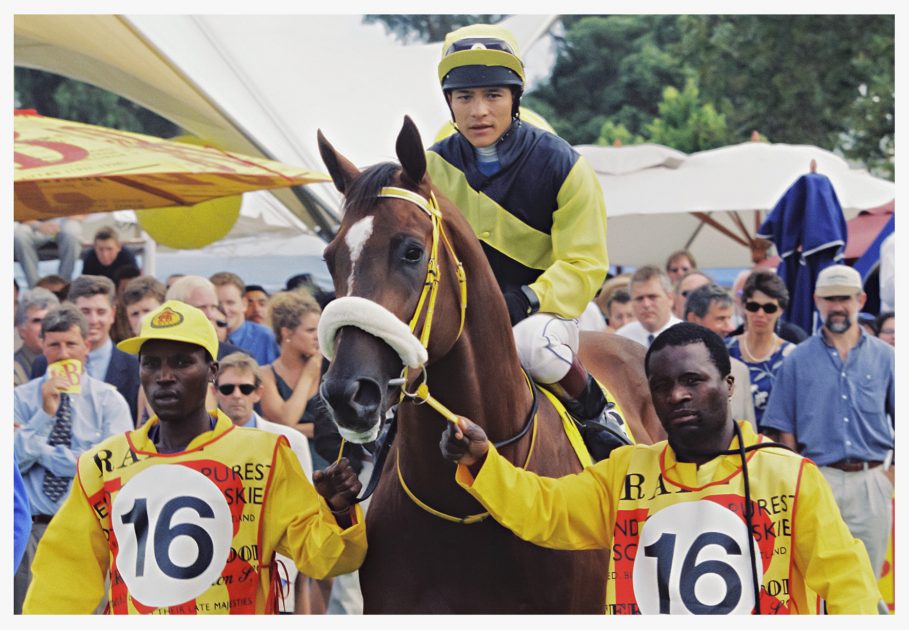
The great Horse Chestnut (Weichong Mawing up) won the 1999 Met by 8 lengths in front of 55 000 people, the all-time record attendance at Kenilworth (Pic courtesy of Robin Bruss)
Horse Chestnut’s majestic win in the 1999 J&B Met as a 3 year old by 8 lengths is the most memorable Met most of us ever saw – and I remember as part of the SABC commentary team noting that the 55,000 strong crowd was the largest ever and the gates of Kenilworth had to be shut early as the House Full signs went up.
This was Kenilworth’s heyday, and racing’s finest moment in Cape Town.
Enjoy a Horse Chestnut flashback:
Watch Pocket Power’s Met win in 2008:
Remember Igugu, who won the Met in 2012?
The J&B Met Sponsorship which lasted over 30 years was not only the whisky brand’s biggest global event, it also yielded Cape Town’s biggest social and sporting event every year with the students of UCT enjoying the biggest open air party of the year and many becoming hooked on the racing game thereafter.
Those of us who have been around a long time, miss those glory days of racing, packed stands and public adulation of the horses.
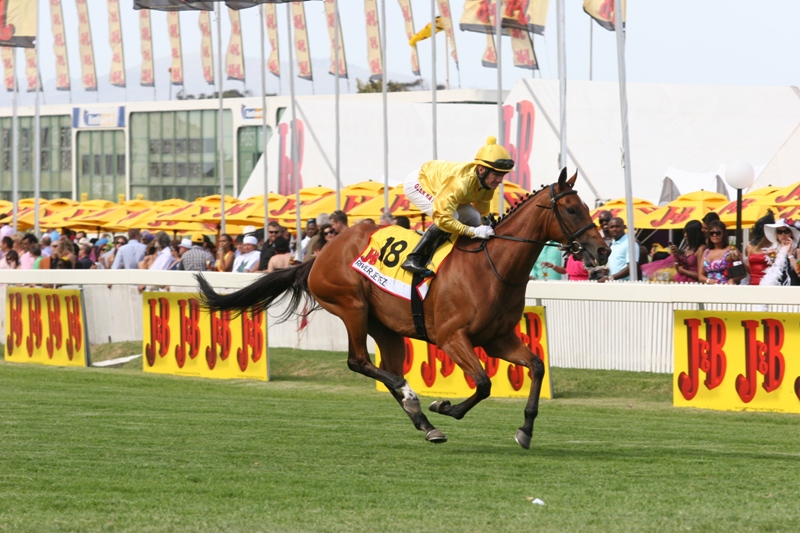
River Jetez – 2010 Met winner
But in witnessing the tour de force that is Greg Bortz and his team at Cape Racing, with the incredible support of Hollywoodbets and L’Ormarins Kings Plate and other sponsors, it is a sense of excitement and pride that ripples through all of us as we head into the 150th anniversary of its founding, in the sure knowledge that Kenilworth’s best days are on their way back.
